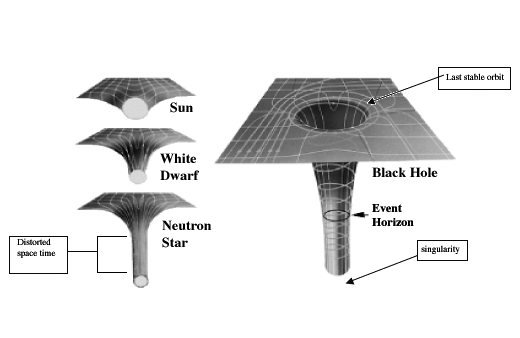High Energy Groove
X-Ray Binary
Level: Grades 7-9
Author: Kimberly S. Adams, Argyle Middle School, Silver Spring, MD
National Science Education Standards:
(
http://www.nap.edu/readingroom/books/nses/html/index.html)
Physical Science: Motion and Forces
- The motion of an object can be described by its position, direction of motion, and speed. That motion can be measured and represented on a graph. (Grades 5-8)
- Gravitation is a universal force that each mass exerts on any other mass. The strength of the gravitational attractive force between two masses is proportional to the masses and inversely proportional to the square of the distance between them. (Grades 9-12)
Earth and Space Science: Earth in the Solar System
- Gravity is the force that keeps planets in orbit around the sun and governs the rest of the motion in the solar system. Gravity alone holds us to the earth's surface and explains the phenomena of the tides. (Grades 5-8)
- Early in the history of the universe, matter, primarily the light atoms hydrogen and helium, clumped together by gravitational attraction to form countless trillions of stars. Billions of galaxies, each of which is a gravitationally bound cluster of billions of stars, now form most of the visible mass in the universe. (Grades 9-12)
Objective:
Students will identify the structure of a black hole.
Students will describe the relationship between the black hole and its companion star.
Enduring Understanding:
Black holes have an infinite density (singularity). If a black hole is close enough to a normal star that material is being pulled from the normal star, they are called x-ray binaries. The material pulled from the companion star creates an accretion disk around the black hole.
Essential Questions:
What is a black hole? What is the relationship between the black hole and its companion star?
Materials (per group of three):
- 10 screw eyes
- Masking tape
- Measuring tape
- Triple beam balance
- 1 plastic 12 oz. clear disposable cup
- 4 Sturdy 8-12 inch paper or styrofoam disposable plates
- Ball of yarn (yarn of various colors has a more dramatic effect)
Vocabulary:
Black Hole, Companion Star, Accretion Disk, Event Horizon, Singularity, X-Ray Binary
Warm up:
Students should read the article "How Black Holes Work," by Craig C. Freudenrich, Ph.D. Have students to pick out one interesting statement from the article to share with the class and tell why they think it is interesting.
Procedure:
- Divide students into groups of three.
Students will complete the following within their groups.
- Trace the larger end of the cup onto the center of four plates. Puncture the middle of the plate with the scissors and cut out the circles just to the inside of the line, creating a doughnut shape. The first plate may be used as a template for the other plates.
- Puncture the bottom of the cup from the inside with a screw eye creating a small hole. The hole should be large enough for the yarn to pull through.
- Place the four plates on top of each other and tape them together to keep from sliding. Secure the cup into the middle of the plates. The cup should be flush with the surface of the top plate.
- Place the screw eyes in the plates in a spiral fashion starting just outside the cup and working towards the outer rim of the plates. (see template) If the screw eyes puncture through the plates, cover the tips with masking tape.
- Wrap the end piece of the yarn with 1 inch of masking tape to create a point. Thus, making it easier to thread through the screw eyes.
- Thread the yarn through the screw eyes starting with the outside rim and working towards the cup. Continue to thread through the hole in the bottom of the cup until the string is hanging a few inches below the bottom of the cup.
- The ball of yarn will represent the COMPANION STAR. One person will hold the companion star. **Measure the circumference and the mass of the companion star and record in the chart.
- The cup will represent the BLACK HOLE and the string surrounding the hole will represent the ACCRETION DISK. The bottom of the cup represents the EVENT HORIZON. The second person will hold the black hole about 10-12 inches away from the companion star.
- The third person will slowly pull the yarn from bottom of the cup. Thus, showing how material is pulled from the companion star into the black hole.
- Once the material is pulled into the black hole it becomes a part of the total mass of the black hole. The material may no longer return to the companion star. Over time the companion star will continually decrease in size.
- Allow students time to complete the chart and explore with the model.
- Check for understanding by discussing the key points of the model: the structure, vocabulary, what happens as the model is in action, the changes in the mass and size of both the companion star and the black hole, larger masses distort space time (see diagram below)

Assessment:
Review the activity sheet as a class to ensure understanding
Finished Model:
Links:



